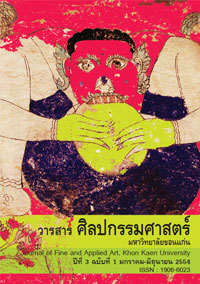พัฒนาการของจิตรกรรมฝาผนังอีสาน กรณีศึกษาจังหวัดขอนแก่น จังหวัดมหาสารคามและจังหวัดร้อยเอ็ด
Main Article Content
Abstract
การวิจัยครั้งนี้มีวัตถุประสงค์เพื่อศึกษา พัฒนาการ การจัดวางรูปแบบองค์ประกอบของจิตรกรรมฝาผนังอีสานจากอดีตถึงปัจจุบัน และพัฒนาการของการนำ วรรณกรรมมาใช้เขียนจิตรกรรมฝาผนังรวมไปถึงแนวความคิดของช่างเขียนจิตรกรรมฝาผนังอีสาน จากอดีตจนถึงปัจจุบันโดยใช้ระเบียบวิธีวิจัยเชิงคุณภาพ มีการรวบรวมเอกสาร การเก็บข้อมูลภาคสนามโดยการสัมภาษณ์ นำเสนอผลการวิเคราะห์ข้อมูลในเชิงพรรณนา และแบบสำรวจโดยได้ผลการศึกษาดังนี้ จากการศึกษาพบว่าพัฒนาการการเขียนจิตรกรรมฝาผนังในจังหวัดขอนแก่น จังหวัดมหาสารคามและจังหวัดร้อยเอ็ด ที่สำรวจพบการเขียนจิตรกรรมฝาผนังตั้งแต่ก่อนปี พ.ศ. 2400 จนถึงปัจจุบัน มีจำนวน 22 วัด สามารถแบ่งการเขียนจิตรกรรมฝาผนังออกเป็น 2 ช่วงใหญ่ๆ คือจิตรกรรมฝาผนังที่สร้างก่อนปี พ.ศ.2500 พบมากถึง 15 วัด และจิตรกรรมฝาผนังที่สร้างหลังปี พ.ศ.2500 พบเพียง 7 วัด ในด้านการจัดวางองค์ประกอบ จิตรกรรมฝาผนังที่สร้างก่อนปี พ.ศ. 2500 ส่วนใหญ่มีการจัดวางองค์ประกอบอย่างไม่เคร่งครัดเพราะช่างเขียนจะถ่ายทอดผลงานออกมาอย่างเรียบง่ายตามความเข้าใจของตน โดยไม่คำนึงถึงกฎเกณฑ์ตามหลักองค์ประกอบทางศิลปะ ผลงานจึงปรากฏอย่างอิสระ เป็นแบบพื้นบ้าน สีที่ใช้เป็นสีจากธรรมชาติ ในส่วนของจิตรกรรมฝาผนังที่สร้างหลังปี พ.ศ. 2500 เป็นต้นมาพบว่าจิตรกรรมฝาผนังส่วนใหญ่นิยมเขียนตามแบบภาพพิมพ์ที่พิมพ์จำหน่ายโดยนาย สม พ่วงภักดี (ส.ธรรมภักดี) และตามแบบจิตรกรรมไทยแนวประเพณี การจัดวางองค์ประกอบนิยมเขียนเป็นภาพขนาดใหญ่ลงบนฝาผนัง มักเขียนภาพไว้ภายในกรอบภาพจบเป็นตอนๆไป โดยส่วนใหญ่จะเขียนเรียงลำดับตามเรื่องราว ตามกรอบภาพที่กำหนดเอาไว้อย่างเป็นระเบียบ มีการเน้นจุดเด่นจุดรองของภาพแต่ละช่องเขียนโดยเขียนให้เต็มผนัง ทุกด้าน ส่วนกลุ่มช่างที่มีฝีมือทางการเขียนจิตรกรรมไทยแนวประเพณี ได้รับอิทธิพลการจัดวางองค์ประกอบจากจิตรกรรมฝาผนังจากภาคกลาง ที่มีการเน้นจุดเด่นของแต่ละเรื่องแต่ละตอน มีการเขียนติดต่อกันเป็นตอน ๆ สามารถดูจากซ้ายไปขวาหรือล่างและบนได้ทั่วทั้งภาพ สีในการเขียน คือสีอะครีลิค และสีนํ้าพลาสติกเพราะมีความทนทานกว่า
ในด้านวรรณกรรมที่ปรากฏในจิตรกรรมฝาผนัง จิตรกรรมที่เขียนก่อนปี พ.ศ. 2500 พบวรรณกรรม กลุ่มเรื่องราวทางศาสนาได้แก่ พุทธประวัติ พระมาลัย ไตรภูมิ ทศชาติชาดก พระเวสสันดรชาดก อรรถกถาชาดก ปริศนาธรรม และกลุ่มวรรณกรรมท้องถิ่น ได้แก่ สินไซ พระลักพระลาม ท้าวปาจิตต์นางอรพิมพ์ ในส่วนของจิตรกรรมฝาผนังที่เขียนหลังปี พ.ศ. 2500 พบกลุ่มวรรณกรรมทางศาสนาได้แก่ พุทธประวัติ พระมาลัย พระเวสสันดรชาดก ทศชาติชาดก และประวัติชุมชน ฮีตสิบสอง ไม่พบวรรณกรรมท้องถิ่น ด้านแนวคิดในการเขียนของช่าง สามารถจำแนกออกได้เป็น 3 กลุ่ม คือ กลุ่มช่างเขียนแบบอีสานประเพณี กลุ่มช่างเขียนแบบอีสานไทยประเพณี และช่างเขียนแบบไทยประเพณีรัตนโกสินทร์ ช่างที่เขียนในลักษณะอีสานประเพณี จะแสดงให้เห็นถึงความเป็นอิสระด้านการแสดงออกที่เรียบง่าย ไม่เคร่งครัดแสดงออกทางความรู้ ความเข้าใจ ตามรสนิยมและทักษะของช่าง พบในจิตรกรรมฝาผนังก่อนปี พ.ศ. 2500 กลุ่มช่างเขียนแบบอีสานไทยประเพณี ซึ่งเป็นช่างชาวอีสานที่ได้รับอิทธิพลมาจากช่างหลวงและช่างภาคกลางหรือไปเรียนรู้ศิลปะจากภาคกลาง มีการเขียนผสมผสานเรื่องราวและรูปแบบระหว่างจิตรกรรมไทยกับรูปแบบความเป็นพื้นถิ่นอีสาน พบทั้งจิตรกรรมฝาผนังก่อนและหลังปี พ.ศ.2500 และช่างเขียนแบบไทยประเพณีรัตนโกสินทร์ เป็นช่างกลุ่มที่ได้รับอิทธิพลมาจากช่างหลวงและช่างภาคกลาง ซึ่งมีทั้งช่างที่มีพื้นเพเป็นคนในพื้นที่อีสานที่ได้ไปศึกษาเรียนรู้ศิลปะจากภาคกลาง ช่างจากภาคเหนือ และช่างที่มาจากภาคกลางโดยตรง นิยมเขียนตามแบบภาพพิมพ์ ของ ส.ธรรมภักดี และเขียนตามแบบจิตรกรรมไทยแนวประเพณี พบในจิตรกรรมฝาผนังในยุคหลัง ปี พ.ศ. 2500
Development of Esan Mural Painting: A Case Study of Khon Kaen, Mahasarakam,and Roi-ed Provinces
The objective of this research was to n study development of arranging the composition of Esan Mural Painting from the past to present, and development of brining literary work in drawing the mural painting as well as viewpoint of painters in Esan Mural Painting from the past to present by using Qualitative Research Methodology, gathering document, collecting field work data by interviewing, descriptive analysis, concluding the findings. The research findings were as follows:
According to the findings found that the development of mural painting in Khon Kaen, Mahasarakam, and Roi-ed Provinces could be classified into 2 major durations as: 1) the mural paintings constructed before 1957, 15 temples were found, and 2) mural paintings after 1957, only 7 temples were found. Most of them were not strictly arranged the composition since the painters would present their art in simple form based on their understanding, without considering the principle of art composition. As a result, their works were independent as locality. The colors were natural colors. For the mural paintings constructed after 1957, found that most of them followed the paintings printed for selling by Mr. Som Puang-pak-dee ( S. Dharma-pak-dee ) as well as Traditional Thai Painting. The composition was drawn as big picture on the wall. The pictures often painted in the frame finishing each section. Most of them were orderly painted in sequence of story based on the determined frame. The prominent and minor point of pictures were highlighted in each channel by painting every side of the full wall. For the painters in group of Traditional Thai Painting, they were influenced by arranging the composition of mural painting from the Central Region, with highlight in prominent point of each story in each section which could be viewed from left to right, or up and down thoroughly the picture. The used colors were Acrylic or Plastic Color since they were more long lasting.
In the literary work on mural painting, the mural painted before 1957, the religious story groups were found including: Buddha’s history, Pra-Malia, Three World and Ten Life of former birth of Buddha, Pra Wedsandon former birth of Buddha, story of former birth of Buddha, Dharma puzzle, and local literary work as: Sinsai, and Pra Lak-Pra Ram,. For birth mural paintings painted after 1957, the religious literary work groups were found including Buddha’s history, Pra Malai, Pra Wedsandon former birth of Buddha, Ten-Life of former birth of Buddha, and community history, and Heat-sib-song. The local literary works were not found.
For painters’ viewpoints in painting, they could be classified into 3 groups: Traditional Esan Painter Group, Traditional Thai Esan Painter Group, and Bangkok Traditional Thai Painters. The Traditional Esan Painters, would express freedom in simple expression, not be strict in expressing their knowledge and comprehension based on their taste and skill, found in group constructing the mural painting before 1957. For Traditional Thai Esan Painters, they were North Eastern Painters influenced by royal painters and Central Region Painters, or studied Art from Central Region. So, they painted by combining stories and patterns between Thai Painting and Esan Local Pattern. For Bangkok Painters, they were painter group influenced by the royal painters and Central Painters. Some of them were North Eastern Painters who studied Art from Central Region. Some of them came from North Region, and some of them came from Central Region. They preferred to paint following the painting of S. Dharama-pak-dee as well as Traditional Thai Painting, found in mural painting in later period of 1957.Article Details
Content and information in articles published in the Journal of Fine and Applied Arts of Khon Kaen University is regarded as the opinion and sole responsibility of the author(s) directly; therefore, editors are not obliged to agree to or share any responsibility with regard to the content and information that appears within these articles.
All articles, information, content, image, etc. that have been published in the Journal of Fine and Applied Arts of Khon Kaen University is the copyright of the Journal of Fine and Appllied Arts of Khon Kaen University. Any person or organization who wishes to distribute all or parts of the articles for further dissemination or other usage must first receive permission from the Journal of Fine and Applied Arts of Khon Kaen University before proceeding to do so.

